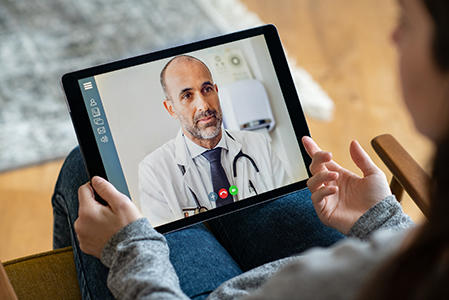Telehealth: What You Need to Know about a Virtual Doctor's Visit
, by Brittany Cordeiro, NCI-CONNECT Program Manager
Neuro-oncology experts share what telehealth is, its benefits and limitations, and what to expect during and after a visit.
The next doctor visit you schedule may be virtual or through telehealth. It enables your doctor to talk with you and examine you at home through video or telecommunication technologies. Hospitals and medical offices across the nation are using telehealth more often so patients do not need to travel or make unnecessary trips outside their home.
“Telehealth is a very important and useful tool to deliver virtual health. It enables doctor-patient interaction and enhances patient care, but does not completely replace face-to-face visits,” says Javier Gonzalez Alarcon, M.D., neuro-oncologist at the NCI Center for Cancer Research's Neuro-Oncology Branch.
According to the National Consortium of Telehealth Resource Centers, telehealth is a collection of means or methods for enhancing health care, public health, and health education delivery and support using telecommunications technologies.
The most conventional type is live video conferencing, where both the doctor and patient use a computer or mobile device with video and audio to have a conversation and medical exam. Other telehealth types include recording a video to send to your doctor, or for your doctor to remotely monitor conditions like epilepsy or sleep disorders.
“Telehealth visits using video conferencing have emerged as an innovative and practical way to provide care to patients with brain and spine tumors,” says Nimish Mohile, M.D., neuro-oncologist at the University of Rochester's Wilmot Cancer Institute.
Telehealth Benefits
Telehealth has rapidly emerged due to changes in access to health care. Its emergence is beneficial to patients and health care providers for many reasons. It is convenient for patients to be at home, or health care providers to be in their office instead of a clinic room during the visit.
It saves money by reducing the time and expenses of travel. Telehealth visits are also usually less complex than in-person visits. Charges associated with the visits may be less.
Telehealth increases access to specialists and support services. People with brain and spine tumors often need to see doctors with specialized training who are at comprehensive cancer centers, either for an initial diagnosis or second opinion. Telehealth removes geographical barriers to allow patients access to the best care.
“We encourage people to get a second opinion so they can be educated and feel comfortable with their treatment options,” says Sara Hardy, M.D., neurologist and radiation oncologist at the Wilmot Cancer Institute. Additionally, patients with brain and spine tumors often have significant symptoms that impact their quality of life. “These can include changes in vision, hearing, and cognition, seizures, weakness, and sometimes depression or anxiety. Team members—including physicians, social workers, and nutritionists—at tertiary care centers can work with them to help positively impact their symptoms and quality of life,” says Dr. Hardy.
Using telehealth, patients can set up visits with specialists or support services when it is convenient for them. Often, patients forgo these services because they do not have time during in-person visits and will not travel again for such services. Patients may also be able to determine eligibility for a clinical trial through a telehealth visit before traveling to enroll.
Telehealth Limitations
Telehealth limitations include technology barriers. Telehealth visits require video, with the exception of counseling or mental health visits. Most medical offices use software or an application to conduct the visit for privacy protection. This means patients need a computer or mobile phone with video and audio capability—and the ability to download and use the necessary software or application for the visit.
“The biggest limitation to telehealth is that we cannot do a conventional physical exam,” Dr. Gonzalez says. Doctors cannot check reflexes, hearing, vision, abnormalities in sensations, or assess weaknesses or feel lymph nodes and areas of swelling.
Prepare for a Telehealth Visit
It is important to prepare for a telehealth visit to optimize the interaction. Your doctor's office may even ask you for some information in advance of your visit. This may include recent magnetic resonance imaging (MRI) scans, tissue samples, or medical reports.
Use this checklist to prepare for your visit:
- Test your equipment. Make sure your video and audio work properly, and you've downloaded any software in advance and know how to operate it.
- Connect your device to a power source or make sure it is fully charged.
- Use a wired internet connection, if possible.
- Write your doctor’s office phone number down in case you lose connection during your visit.
- Close all unnecessary programs on your device to avoid it running slower and for privacy protection.
- Check with your insurance about coverage.
- Find a quiet space with adjustable lighting and room to move. You will most likely have to walk, raise your arms, or perform other movements.
- Make a list of your medications, dosages, and frequency, and also have the medication bottles nearby.
- Make sure your caregiver or a family member can join the visit, too. Like an in-person visit, it can be helpful to have support, a second set of ears, a notetaker, or someone to hold the camera when you perform movements.
- Write down your questions and concerns, such as changes in symptoms or new symptoms.
Use this form to help you prepare
You can also prepare for your visit by checking your own vitals—body temperature, blood pressure, heart rate, and weight. Write down the numbers and have them ready to share with your doctor.
Watch this video to learn how to check your own vitals
During a Telehealth Visit
Understanding what will happen during your telehealth visit can help you prepare and feel at ease.
Ask if you can record your visit or if your doctor can provide a summary. Try to stay engaged by treating it the same as an office visit. A typical visit includes talking about your history since your last visit. This includes new or worsening symptoms, other changes, and going through medications. Then, your doctor will perform a medical exam.
The medical exam will include observation—viewing rashes, infections, surgical scars, and swelling. “We can look at a swollen calf and assess if we think it’s a blood clot,” Dr. Mohile says.
A telehealth visit is similar to an in-person visit because it is a conversation, an evaluation, and an opportunity to connect.
Your doctor will assess cognition—memory, attention, concentration, and language—through verbal tests like naming and repeating things. Your doctor can assess brain functioning through a neurological exam—viewing eye movements, facial weakness, strength, walking, and coordination.
“We can see whether strength is symmetric across the body, for example, and whether both arms and legs can do similar activities,” Dr. Mohile explains.
Your doctor will also be able to share his or her screen and show you imaging results, pathology, and lab reports. He or she can also write out instructions and information about medications, diets, and other treatment recommendations.
Before your appointment ends, make sure you ask all your questions and share your concerns. Make sure you understand the plan or next steps. Will you receive a calendar invite for your next appointment? Who will arrange your next appointment or MRI? Do you need a referral? And, if so, what is the process?
Reminders about Telehealth
It is important that you are honest with your doctor during your telehealth visit. If you are having problems with the technology or trouble hearing or seeing the screen, tell your doctor. They can troubleshoot and adjust to improve your experience.
“Patients should also feel comfortable having conversations about intimate or difficult things,” Dr. Mohile says. This includes advanced care planning.
“Telehealth has given us the flexibility to have in-depth conversations during our visits to really make a connection with patients and their families,” Dr. Hardy adds. “While telehealth will never completely replace face-to-face visits, it is a very important addition.”

